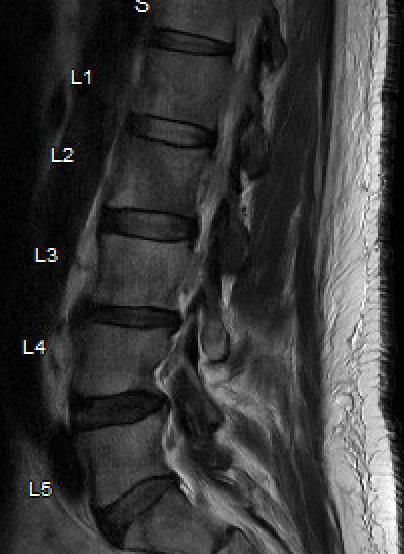Tuesday Poster Session
Category: Stomach and Spleen
P6379 - From Biopsy to Diagnosis: Lumbar Vertebral Metastasis Unveiling Advanced Gastric Adenocarcinoma
Tuesday, October 28, 2025
10:30 AM - 4:00 PM PDT
Location: Exhibit Hall
.jpg)
Rahul Patel, DO (he/him/his)
Northeast Georgia Medical Center
Phoenix, AZ
Presenting Author(s)
Rahul Patel, DO, Sandus Khan, MD, Abdelrahman Yakout, MD
Northeast Georgia Medical Center, Gainesville, GA
Introduction: Gastric adenocarcinoma is the fourth leading cause of cancer death and the fifth most commonly diagnosed cancer globally. Gastric adenocarcinoma typically metastasizes to the liver, peritoneum, and regional lymph nodes. Bone metastasis, usually to the lumbar spine, is very rare with an incidence of only 0.9-3.8% according to some studies. We present an unusual presentation of gastric adenocarcinoma where the diagnosis was established following bone biopsy of suspected bony metastasis.
Case Description/
Methods: A 51 yo male with no significant past medical history presented to the ED with hematemesis and abdominal pain that started less than 12 hours ago. Patient was found to have a hemoglobin of 4.8 and thrombocytopenia on labs. Initial CT scans negative for acute hemorrhage, but noted moderate abdominal ascites. Patient then endorsed lumbar back pain worsened acutely as well, with imaging revealing suspected bony metastasis. Heme/onc was consulted and recommend bone biopsy given flow cytometry showed minority population of circulating CD34-positive blasts. Bone biopsy revealed metastatic poorly differentiated non-small cell, non-squamous carcinoma with extensive necrosis. EGD was unable to be performed during initial stages due to severe thrombocytopenia, but was performed after platelets improved. EGD showed a large ulcerated gastric mass in the antrum, highly suspicious for primary malignancy. Gastric biopsy results showed a poorly differentiated adenocarcinoma. Initial radiation therapy for severe back pain was initiated with plans for chemotherapy afterwards, however patient developed worsening cytopenia with RT. Heme/onc specialists discussed poor prognosis with patient and family, especially given inability to start treatment given worsening cytopenia. Decision made to pursue hospice care by patient and family.
Discussion: Prognosis of gastric adenocarcinoma is already poor, but with bone metastasis survival is often limited to few months. Mainstay treatment is largely palliative with systemic chemotherapy, radiotherapy, and bone targeting agents. Unfortunately in this case the patient did not have any symptoms suspicious for malignancy until the disease was fairly advanced. This case highlights considering rare primary tumor sites, such as gastric cancer, in patients that present with bony metastases with unknown primary tumor. AI tools were used to help create this abstract.

Figure: Bony Metastasis on MRI Lumbar Spine
Disclosures:
Rahul Patel indicated no relevant financial relationships.
Sandus Khan indicated no relevant financial relationships.
Abdelrahman Yakout indicated no relevant financial relationships.
Rahul Patel, DO, Sandus Khan, MD, Abdelrahman Yakout, MD. P6379 - From Biopsy to Diagnosis: Lumbar Vertebral Metastasis Unveiling Advanced Gastric Adenocarcinoma, ACG 2025 Annual Scientific Meeting Abstracts. Phoenix, AZ: American College of Gastroenterology.
Northeast Georgia Medical Center, Gainesville, GA
Introduction: Gastric adenocarcinoma is the fourth leading cause of cancer death and the fifth most commonly diagnosed cancer globally. Gastric adenocarcinoma typically metastasizes to the liver, peritoneum, and regional lymph nodes. Bone metastasis, usually to the lumbar spine, is very rare with an incidence of only 0.9-3.8% according to some studies. We present an unusual presentation of gastric adenocarcinoma where the diagnosis was established following bone biopsy of suspected bony metastasis.
Case Description/
Methods: A 51 yo male with no significant past medical history presented to the ED with hematemesis and abdominal pain that started less than 12 hours ago. Patient was found to have a hemoglobin of 4.8 and thrombocytopenia on labs. Initial CT scans negative for acute hemorrhage, but noted moderate abdominal ascites. Patient then endorsed lumbar back pain worsened acutely as well, with imaging revealing suspected bony metastasis. Heme/onc was consulted and recommend bone biopsy given flow cytometry showed minority population of circulating CD34-positive blasts. Bone biopsy revealed metastatic poorly differentiated non-small cell, non-squamous carcinoma with extensive necrosis. EGD was unable to be performed during initial stages due to severe thrombocytopenia, but was performed after platelets improved. EGD showed a large ulcerated gastric mass in the antrum, highly suspicious for primary malignancy. Gastric biopsy results showed a poorly differentiated adenocarcinoma. Initial radiation therapy for severe back pain was initiated with plans for chemotherapy afterwards, however patient developed worsening cytopenia with RT. Heme/onc specialists discussed poor prognosis with patient and family, especially given inability to start treatment given worsening cytopenia. Decision made to pursue hospice care by patient and family.
Discussion: Prognosis of gastric adenocarcinoma is already poor, but with bone metastasis survival is often limited to few months. Mainstay treatment is largely palliative with systemic chemotherapy, radiotherapy, and bone targeting agents. Unfortunately in this case the patient did not have any symptoms suspicious for malignancy until the disease was fairly advanced. This case highlights considering rare primary tumor sites, such as gastric cancer, in patients that present with bony metastases with unknown primary tumor. AI tools were used to help create this abstract.

Figure: Bony Metastasis on MRI Lumbar Spine
Disclosures:
Rahul Patel indicated no relevant financial relationships.
Sandus Khan indicated no relevant financial relationships.
Abdelrahman Yakout indicated no relevant financial relationships.
Rahul Patel, DO, Sandus Khan, MD, Abdelrahman Yakout, MD. P6379 - From Biopsy to Diagnosis: Lumbar Vertebral Metastasis Unveiling Advanced Gastric Adenocarcinoma, ACG 2025 Annual Scientific Meeting Abstracts. Phoenix, AZ: American College of Gastroenterology.
